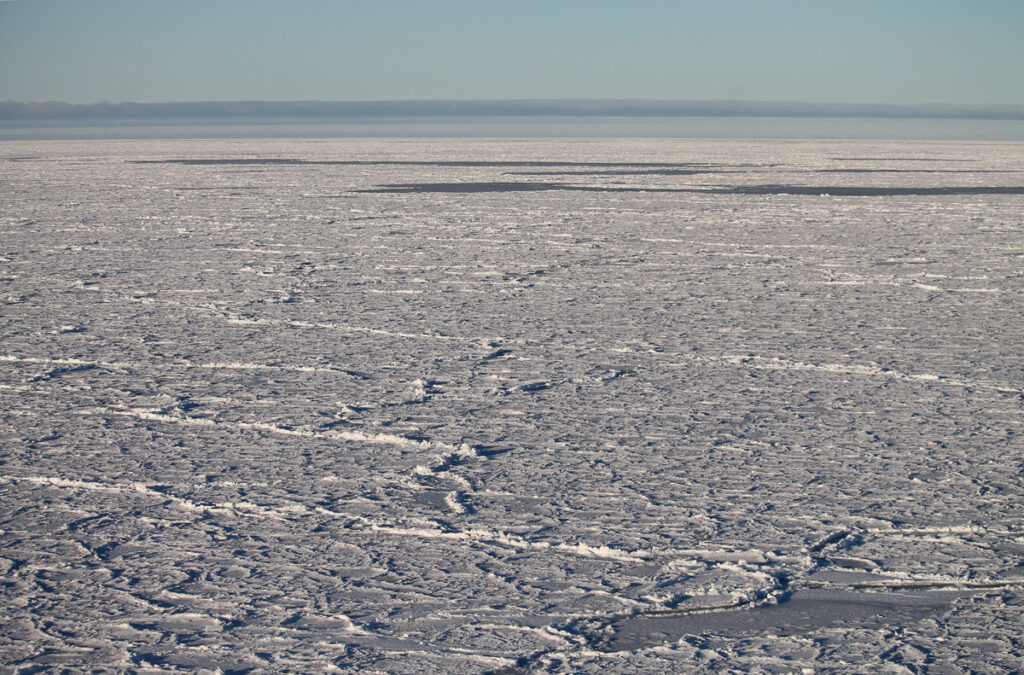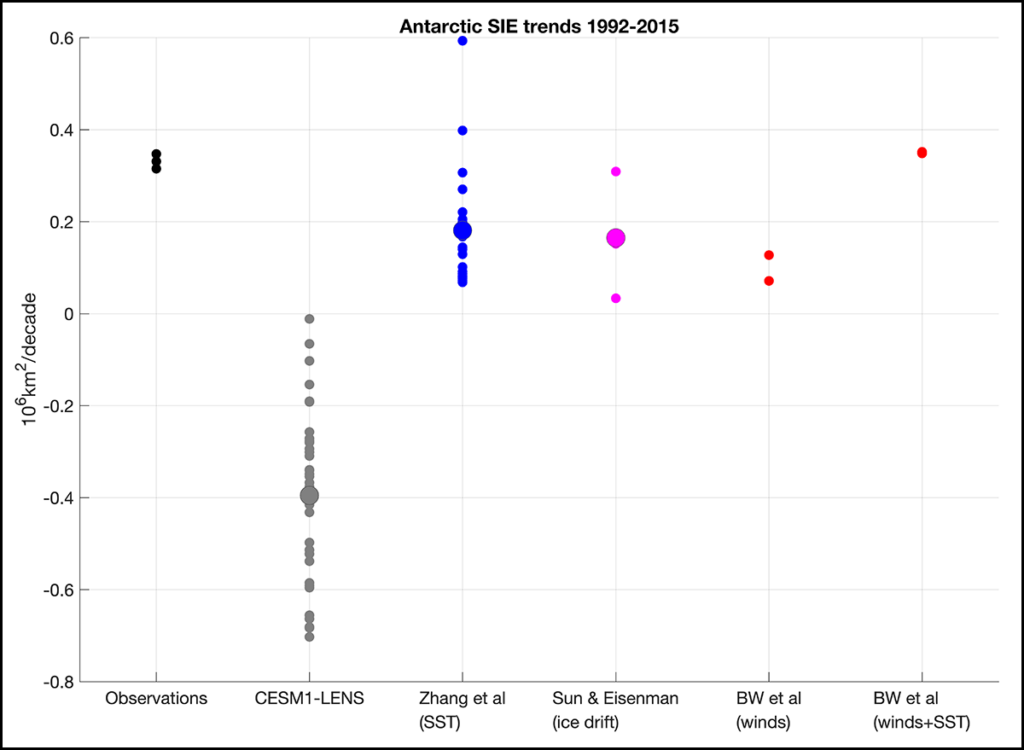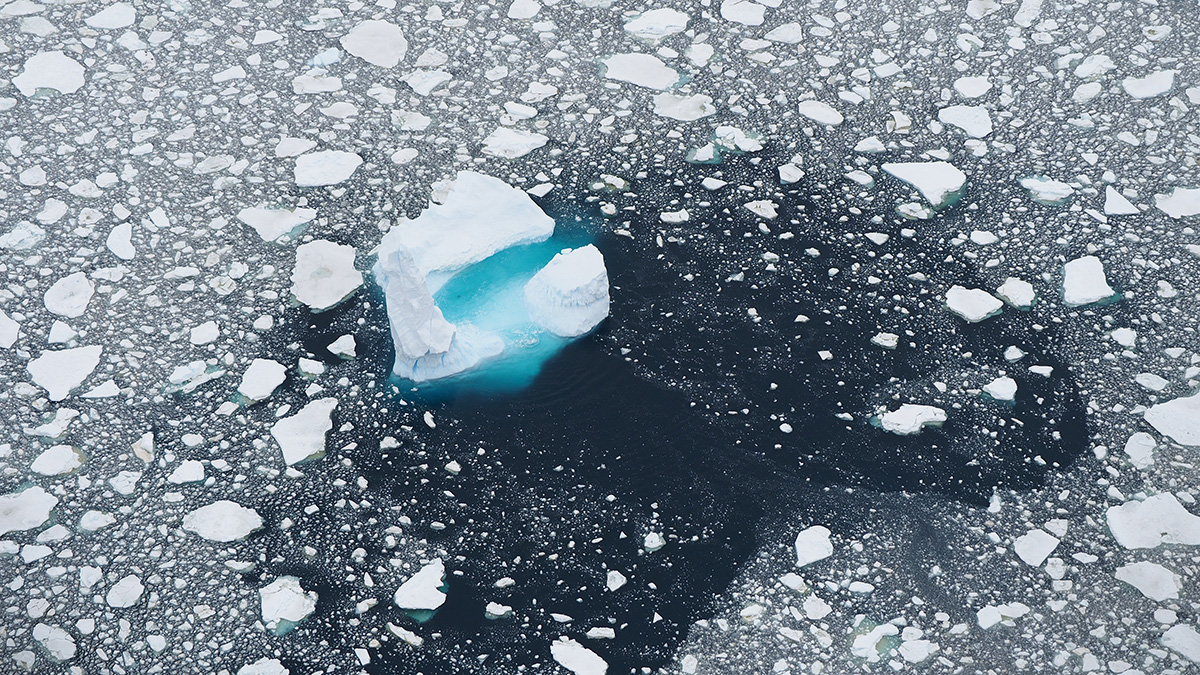Sea ice covers the ocean surrounding Antarctica, forming a key component of the coupled ocean-atmosphere-cryosphere system in southern high latitudes that helps regulate climate, ocean circulation, and marine ecosystems. The extent of Antarctic sea ice varies greatly from year to year, but 40 years of satellite records show a long-term trend. Although some Antarctic regions have experienced reductions in sea ice extent, the overall trend since 1979 shows increased ice.
The increase in Antarctic sea ice extent stands in stark contrast to conditions in the Arctic, where sea ice extent has declined significantly—by about 2 million square kilometers, or about 20%, over the past 40 years. Much of the observed loss of Arctic sea ice, which is in general agreement with expectations from climate models, has been attributed to anthropogenic global warming.
The trend in Antarctic sea ice, meanwhile, has confounded scientists—most climate models indicate that Antarctic sea ice extent should have decreased over the past several decades. Here we discuss results from three recent independent studies that all applied a “nudging” technique to the same climate model to study the influences of different processes on Antarctic sea ice extent.
Where Models and Observations Differ
The state of sea ice is usually described in terms of its aerial extent, which has been measured since 1979 by satellite platforms that detect differences in microwave emissivity of sea ice versus open ocean. The inability of climate models to simulate satellite-observed Antarctic sea ice trends adds uncertainty to our projections of how this sea ice will change through the 21st century.
These model simulations, which are widely used to understand and predict climate change more broadly (e.g., for the Intergovernmental Panel on Climate Change (IPCC) Assessment Reports), are run using observed (for past time periods) or prescribed (for future time periods) conditions, called external forcings. These forcings include factors such as the concentrations and compositions of greenhouse gases and aerosols in the atmosphere. However, these models are also “free-running” throughout their simulations—that is, they do not assimilate (incorporate) any new weather information as the model is running.
In the past decade or so, researchers have sought to unravel the mechanisms controlling Antarctic sea ice extent and to explain shortcomings in models.
In the past decade or so, researchers have sought to unravel the mechanisms controlling Antarctic sea ice extent and to explain shortcomings in models. Many mechanisms have been proposed, some involving other environmental changes that have taken place in Antarctica. Examples of these changes include those in the size and shape of the stratospheric ozone hole, atmospheric circulation patterns (some of them as a result of the ozone hole), precipitation and temperature, surface ocean freshening, and poorly constrained land ice calving events.
One novel approach to identify the mechanisms behind observed trends is to use a nudging technique. In this technique, one or several variables in a climate model are relaxed, or nudged, toward an observed value (over either the whole model domain or a part of it) while the rest of the model is left unchanged (i.e., free-running). A comparison of three recent studies in which winds, ice drift, and sea surface temperatures were nudged individually or in combination yields valuable insights into the influence of these factors on Antarctic sea ice extent.
Winds and Ice Drift
Antarctic sea ice is strongly coupled to the overlying atmosphere through winds, air temperatures, and other factors. Because sea ice drift is strongly controlled by surface winds, trends in surface winds can create corresponding trends in sea ice drift [e.g., Holland and Kwok, 2012]. Wind can also indirectly affect sea ice across different seasons through its influence on the open ocean (e.g., by affecting mixing of the upper ocean layers and the heat fluxes between the ocean and atmosphere). For example, spring winds that lead to summer cooling of sea surface temperatures (SSTs) may enhance sea ice formation in the subsequent fall freeze-up.

Over the past 40 years, significant trends have been observed in atmospheric circulation over Antarctica. These trends, which are important for sea ice, include a strengthening of the westerlies and a deepening of the cyclonic Amundsen Low. The trends are a result of complex interactions between natural (internal) variability and external forcings such as changes in atmospheric ozone and greenhouse gases. Yet climate models tend to underestimate coupling between winds and sea ice as well as these decades-long atmospheric circulation trends [e.g., Holland et al., 2017].
To isolate and quantify the impact of winds on Antarctic sea ice, Blanchard-Wrigglesworth et al. [2021] recently simulated conditions in the region. We used the National Center for Atmospheric Research (NCAR) Community Earth System Model Version 1 Large Ensemble (CESM1-LENS), with standard historical and 21st century forcings from the Coupled Model Intercomparison Project Phase 5 (CMIP5, which is the broad climate modeling effort that informed the IPCC’s Fifth Assessment Report). In this study, the modeled winds (speeds and directions) above the atmosphere’s boundary layer were nudged to match observations from 1979 to 2018 for latitudes above 45°.
This result suggests that winds play a major role in the observed trends but are not the only factor leading to Antarctic sea ice expansion.
Under this configuration, the model winds were constrained to follow the past observations over these high latitudes, but all other processes in the model, including the sea ice–atmosphere coupling at the surface, were left unconstrained. In this work, half of the discrepancy between the observed trend in total sea ice extent around Antarctica since 1979 and the projections of its extent from the CESM1-LENS was eliminated. This result suggests that winds play a major role in the observed trends but are not the only factor leading to Antarctic sea ice expansion. Trends in regional sea ice extent in this experiment showed spatial patterns similar to observations, yet as with the overall trend, the calculated regional trends were still biased toward smaller ice extents relative to observations.
To investigate the impact of wind-driven ice motion on sea ice expansion from another angle, Sun and Eisenman [2021] ran separate experiments with CESM1 that directly nudged sea ice drift in the model to match satellite-derived drift observations from 1992 to 2015. This approach eliminated possible model biases introduced by simulating the coupling between winds and sea ice drift and thus had the advantage of isolating the effects of ice motion alone. However, it had the disadvantage of not accounting for potential indirect effects of winds on sea ice (such as by summer winds over open ocean), thus omitting processes that could drive ice expansion. In their results, Sun and Eisenman show that their simulations reproduce a significant portion of the observed sea ice trend and also capture regional patterns.
Southern Ocean Surface Temperatures
Antarctic sea ice is bordered by the ice-free Southern Ocean, which itself has experienced cooling SSTs over recent decades. This cooling trend is partly due to natural variability and partly due to upwelling currents that bring to the surface deep waters that have not yet warmed because of anthropogenic climate change [e.g., Armour et al., 2016].
Most climate models do not simulate the observed cooling of the Southern Ocean, and thus, this model bias may contribute to inaccurate simulation of Antarctic sea ice trends. If a model did reproduce the observed Southern Ocean SST cooling, would it also simulate observed sea ice trends?
Regional patterns of wind and ice drift are crucial for understanding regional trends in sea ice extent.
Zhang et al. [2021] addressed this question through ensemble modeling with CESM1 that nudged Southern Ocean SST anomalies to match the observed anomalies from 1979 to 2013. In these experiments, the ensemble mean Antarctic sea ice trend over this period is near zero, meaning there was no change in extent. This trend compares with a calculated loss of 0.36 million square kilometers of sea ice per decade in the free-running CESM1-LENS model and an actual observed gain of 0.23 million square kilometers per decade. Thus, the SST nudging compensates for 60% of the model bias seen with CESM1-LENS (0.36 million out of 0.59 million square kilometers per decade).
However, regional sea ice trends seen in these SST-nudged experiments are rather different from observations, with the model showing regional sea ice extent loss in some regions where increases were observed and vice versa. This difference hints that regional patterns of wind and ice drift, which the SST-nudged experiments did not constrain, are crucial for understanding regional trends in sea ice extent.
Winds and Sea Surface Temperatures Acting Together
To further assess the role of Southern Ocean SSTs, Blanchard-Wrigglesworth et al. [2021] ran another set of experiments in which both winds and Southern Ocean SST anomalies were nudged to match observations from 1979 to 2018. In these experiments, the overall sea ice trend was essentially zero, compared with the 0.4 million square kilometers lost per decade calculated in CESM1-LENS from 1979 to 2018 and with the observed trend of 0.1 million square kilometers added per decade. Thus, these experiments in which both winds and SSTs were nudged captured 80% of the discrepancy between the observed trend and that simulated by CESM1-LENS. The regional sea ice trends in these experiments were only slightly improved compared to the regional sea ice trends in the winds-only nudged experiments, indicating that winds are more important than remote SSTs for regional sea ice trends.
Taken together and comparing a common 1992–2015 period, these three studies suggest that both Southern Ocean SST cooling and winds and sea ice drift have contributed to the growth of sea ice extent around Antarctica (Figure 1). There is certainly still more complexity to unravel, though. For example, simply adding the effects of the SST-nudged simulation to either the wind- or direct ice drift–nudged simulations appears to overshoot the observed trend, which is likely because Southern Ocean SSTs and winds are not independent of each other. Indeed, in the wind-nudged simulations by Blanchard-Wrigglesworth et al. [2021], the Southern Ocean shows weaker warming than in the free-running version of the model, hinting that these factors are coupled.

Still, these studies bring us closer to understanding the surprising behavior of Antarctic sea ice. They also highlight the potential of novel nudging experiments to quantify the effects of specific processes on climate change, and they pose new questions such as what drove Southern Ocean cooling and trends in winds. With continued observations and experiments, we may eventually solve a mystery that has long puzzled scientists, and we will be better positioned to forecast vital and interacting changes in sea ice and climate.
Acknowledgments
Funding for these projects was provided by the National Science Foundation’s (NSF) Antarctic Program (PLR1643436, Blanchard-Wrigglesworth et al. [2021]) and Office of Polar Programs (OPP-1643445, Sun and Eisenman [2021]). All authors acknowledge high-performance computing support from the Cheyenne supercomputer and NCAR’s Computational and Information Systems Laboratory, sponsored by NSF.
References
Armour, K. C., et al. (2016), Southern Ocean warming delayed by circumpolar upwelling and equatorward transport, Nat. Geosci., 9(7), 549–554, https://doi.org/10.1038/ngeo2731.
Blanchard-Wrigglesworth, E., et al. (2021), Impact of winds and Southern Ocean SSTs on Antarctic sea ice trends and variability, J. Clim., 34(3), 949–965, https://doi.org/10.1175/JCLI-D-20-0386.1.
Holland, P. R., and R. Kwok (2012), Wind-driven trends in Antarctic sea-ice drift, Nat. Geosci., 5(12), 872–875, https://doi.org/10.1038/ngeo1627.
Holland, M. M., et al. (2017), Springtime winds drive Ross Sea ice variability and change in the following autumn, Nat. Commun., 8(1), 1–8, https://doi.org/10.1038/s41467-017-00820-0.
Sun, S., and I. Eisenman (2021), Observed Antarctic sea ice expansion reproduced in a climate model after correcting biases in sea ice drift velocity, Nat. Commun., 12(1), 1–6, https://doi.org/10.1038/s41467-021-21412-z.
Zhang, X., C. Deser, and L. Sun (2021), Is there a tropical response to recent observed Southern Ocean cooling?, Geophys. Res. Lett., 48(5), e2020GL091235, https://doi.org/10.1029/2020GL091235.
Author Information
Edward Blanchard-Wrigglesworth ([email protected]), University of Washington, Seattle; Ian Eisenman, University of California, San Diego, La Jolla; Sally Zhang, National Center for Atmospheric Research, Boulder, Colo.; Shantong Sun, California Institute of Technology, Pasadena; and Aaron Donohoe, University of Washington, Seattle

